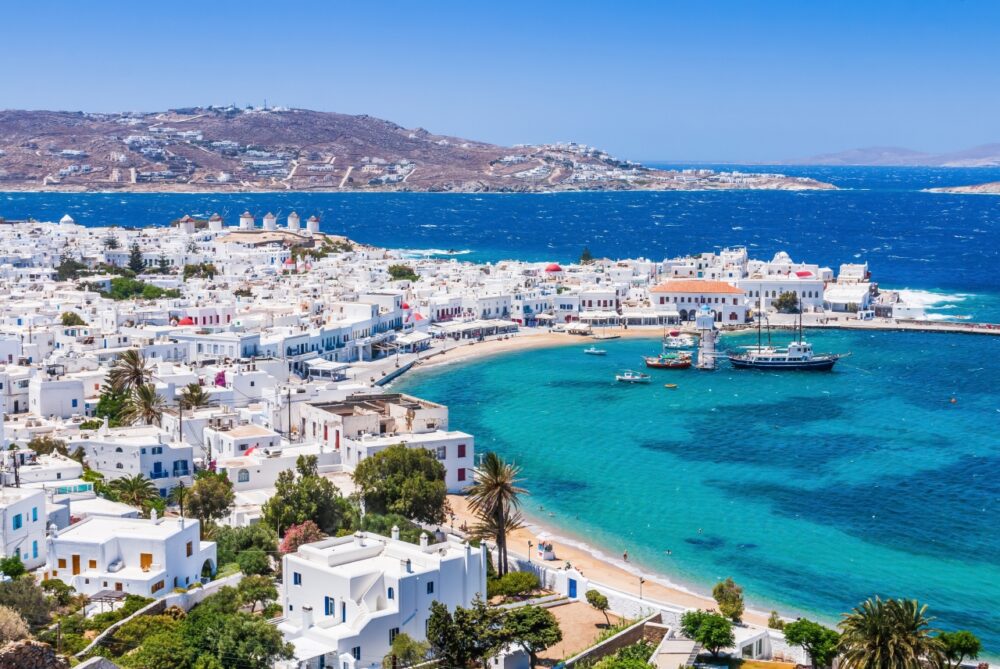
Is Mykonos worth visiting? Without a doubt! The first time I set foot on this glamorous Greek island, I was captivated by its striking mix of natural beauty and chic, cosmopolitan vibe. Wandering through the iconic whitewashed streets of Mykonos Town, with bougainvillaea spilling from every corner, and watching the sun dip below the horizon from Little Venice, I quickly understood why Mykonos has earned its spot as one of Greece’s most famous destinations.
Located in the heart of the Cyclades in Greece, Mykonos is renowned for its stunning beaches, vibrant nightlife, and luxurious atmosphere. From the iconic windmills overlooking Mykonos Town to the crystal-clear waters of Psarou and Paradise Beach, the island is a haven for relaxation and excitement. Whether you’re here to party until dawn, unwind in the sun, or explore its rich history (Delos, anyone?), Mykonos offers an unforgettable experience for every traveller. But is Mykonos worth visiting for you?
In this blog post, we’ll explore the top 10 reasons why Mykonos should be on your travel list, from its picturesque beauty to its buzzing social scene. Plus, we’ll share practical travel tips to help you make the most of your time on this stunning island. Keep reading to discover why Mykonos might just become your dream Greek getaway.
Table of Contents
Pros – Reasons You Should Visit Mykonos
1. Picture-Perfect Cycladic Architecture
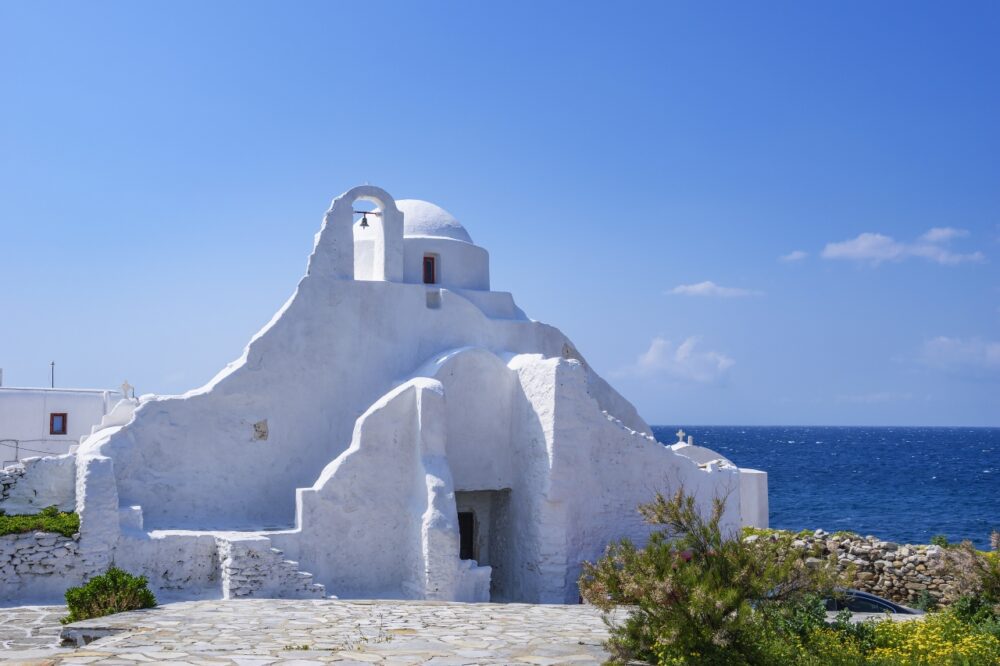
Mykonos is famed for its whitewashed buildings, narrow winding streets, and iconic blue-domed churches, creating the quintessential Cycladic aesthetic.
Strolling through the maze-like streets of Chora, the island’s main town, was a delight. Every turn revealed postcard-worthy views, from vibrant bougainvillaea cascading over walls to hidden courtyards. If you’re a photography enthusiast, you’ll find endless inspiration in Mykonos’ architectural beauty.
2. Stunning Beaches
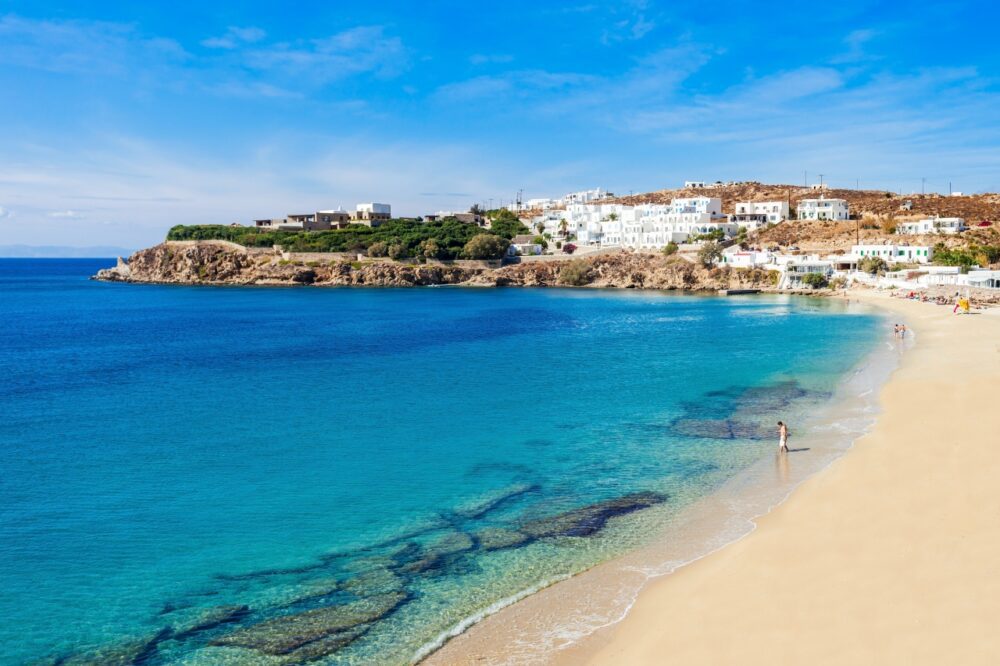
Mykonos is home to some of the most beautiful beaches in Greece, ranging from lively party spots to secluded coves. Popular choices include Paradise Beach, Super Paradise Beach, and the quieter Agios Sostis.
I spent a blissful afternoon at Elia Beach, where soft golden sand and crystal-clear waters provided the perfect escape. For a more relaxed vibe, Kapari Beach offered tranquillity away from the crowds. Mykonos’ beaches cater to every type of traveller, whether you want to lounge in luxury or connect with nature.
3. World-Class Nightlife
Mykonos is often dubbed the Ibiza of Greece, and for good reason. The island boasts a legendary nightlife scene, with beach clubs, chic cocktail bars, and world-renowned DJs performing in glamorous venues.
I danced the night away at Cavo Paradiso, a cliffside club overlooking the sea, and enjoyed sundowner cocktails at Scorpios. Whether you’re a party animal or prefer a laid-back evening with live music, Mykonos knows how to entertain after dark.
4. Gorgeous Sunsets
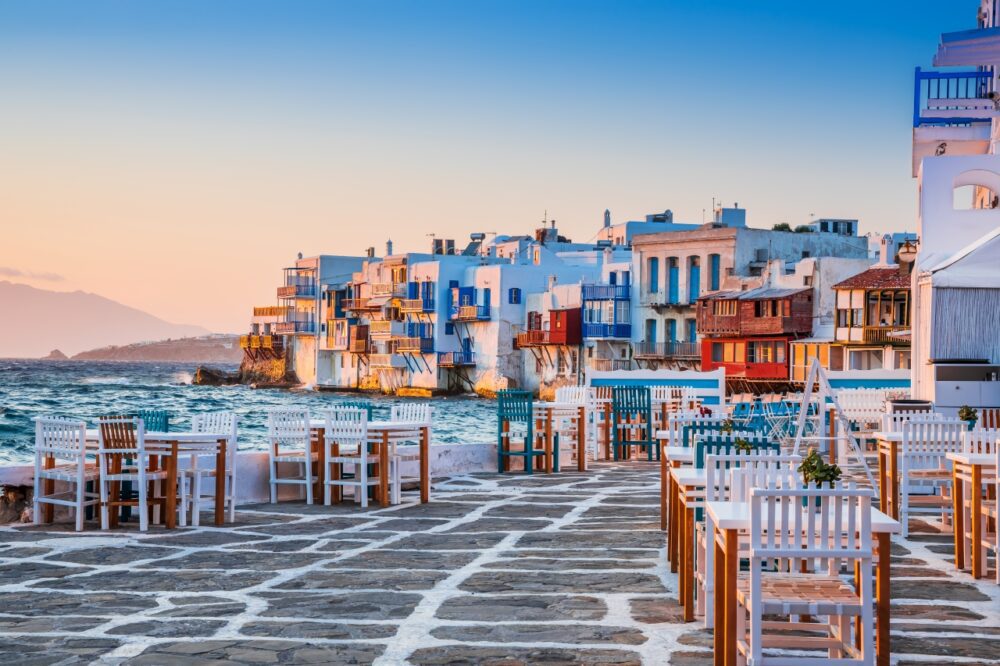
Few experiences in Mykonos rival the magic of its sunsets. Popular spots like Little Venice, where colourful buildings line the waterfront, offer stunning views as the sun dips into the Aegean Sea.
I grabbed a drink at a waterfront bar in Little Venice and watched the sky turn vibrant shades of orange and pink. It was the perfect way to end a day on the island. Mykonos sunsets are nothing short of mesmerising.
5. Luxurious Accommodations
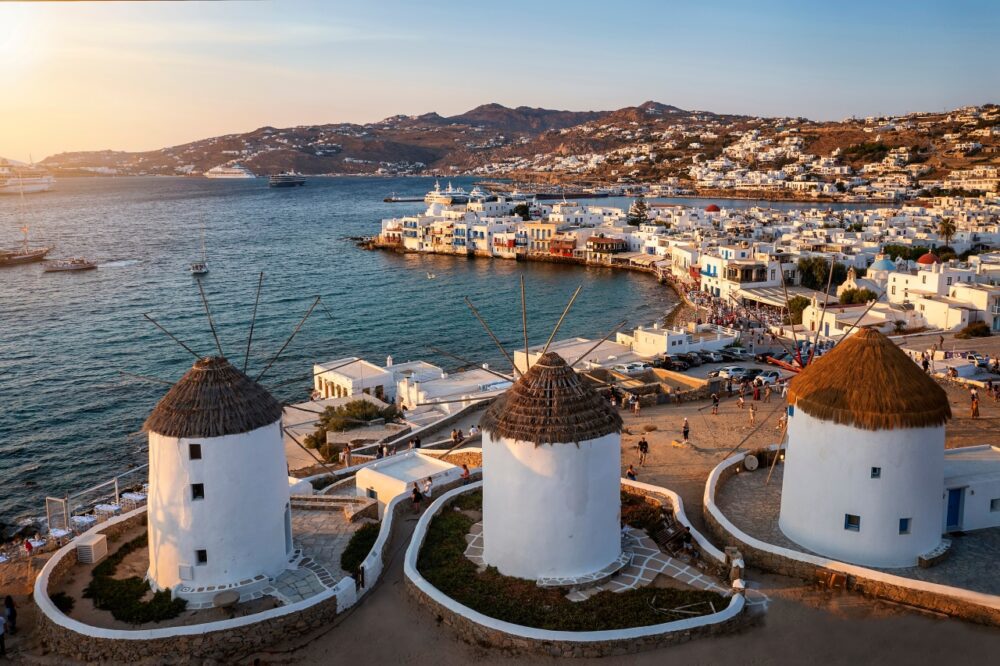
Mykonos is synonymous with luxury, and the island offers an array of high-end resorts, boutique hotels, and private villas. Many properties feature infinity pools, stunning sea views, and world-class service.
I stayed in a boutique hotel with a private terrace overlooking the sea, and it felt like pure indulgence. For those willing to splurge, Mykonos offers some of the most memorable stays you can imagine.
6. Delicious Greek Cuisine
From fresh seafood to traditional Greek dishes, Mykonos’ culinary scene is a highlight of any visit. Local tavernas and upscale restaurants serve up flavours that celebrate the island’s rich gastronomic heritage.
One of my best meals was at Kiki’s Tavern, a no-frills spot near Agios Sostis Beach, where the grilled octopus and salads were divine. For a more upscale experience, Nammos combines fine dining with a beachside setting.
7. Vibrant Local Culture
Despite its international appeal, Mykonos retains a sense of local culture. From traditional festivals to its charming fishing harbours, the island offers glimpses into its authentic side.
I visited during a local festival in Ano Mera, the island’s second-largest village, where traditional music, dancing, and food created a warm and welcoming atmosphere. Exploring beyond the main tourist hubs reveals a deeper connection to the island’s roots.
8. Proximity to Delos
Mykonos serves as a gateway to Delos, an uninhabited island and UNESCO World Heritage Site, famed for its ancient ruins and mythological significance as the birthplace of Apollo and Artemis.
A short boat ride took me to Delos, where I spent hours exploring its well-preserved temples and theatre. The island’s history and serene beauty make it a must-visit for history enthusiasts.
9. Friendly and Welcoming Locals
Mykonos’ residents are known for their hospitality, and their warmth adds to the island’s charm. From shopkeepers to taverna owners, locals often go out of their way to make visitors feel welcome.
During my stay, I struck up conversations with locals who shared insider tips on the best beaches and hidden gems. Their kindness and enthusiasm for their home made my visit all the more special.
10. A Blend of Relaxation and Glamour
Mykonos strikes a balance between serene retreats and glamorous indulgence. Whether you’re seeking quiet moments by the sea or high-energy nights in chic clubs, the island has it all.
I spent my mornings exploring secluded beaches and afternoons sipping cocktails by an infinity pool. The variety of experiences Mykonos offers ensures every visitor can craft their ideal holiday.
Cons – Things to Consider When Visiting Mykonos
1. High Costs
Mykonos is one of the most expensive destinations in Greece, with premium prices for accommodation, dining, and nightlife. Budget travellers may find the costs challenging.
I quickly realised how pricey the island can be when a basic meal cost double what I’d paid on other Greek islands. If you’re visiting Mykonos on a budget, consider staying in simpler accommodations and seeking out local tavernas rather than high-end spots.
2. Overcrowding in Peak Season
During the summer months, Mykonos becomes a hotspot for tourists, which can lead to crowded beaches, long waits at restaurants, and a loss of the island’s laid-back charm.
I visited in July and found the main streets of Chora packed with visitors, making it harder to enjoy the atmosphere. For a more peaceful experience, consider travelling in the shoulder seasons of May or September.
3. Limited Public Transport
Getting around Mykonos can be challenging, as public transport options are limited and taxis are often scarce and expensive. Renting a car or scooter is a popular alternative but comes with its own challenges.
I opted for a scooter rental, which gave me the freedom to explore but required careful navigation on the island’s narrow and winding roads. Planning your transport in advance is essential to avoid frustration.
4. Party-Centric Atmosphere
While Mykonos is famous for its nightlife, the party scene might not appeal to everyone. Visitors seeking a more tranquil or family-friendly destination may find the island’s reputation overwhelming.
I found the party vibe fun but noticed that it dominated certain areas, like Paradise Beach. If you’re looking for a quieter escape, focus on less touristy spots or consider other Greek islands like Naxos or Paros.
5. Environmental Concerns
Like many popular destinations, Mykonos faces challenges with over-tourism, including strain on natural resources and waste management issues. Visitors should be mindful of their environmental impact.
I made an effort to support local businesses and avoid single-use plastics during my trip. Being a responsible traveller can help mitigate the pressures of tourism on this beautiful island.
When to Visit Mykonos
The best times to visit Mykonos are late spring (May to early June) and early autumn (September to October), when the weather is warm, the beaches are less crowded, and the Aegean waters are perfect for swimming. These shoulder seasons allow you to enjoy the island’s charm without the overwhelming crowds and high prices of peak summer. Summer (July and August) is the busiest time, drawing visitors with its lively beach parties, luxury yachts, and endless sunshine, but it also means packed beaches and premium prices. Winter is quieter, and while the nightlife slows down, it’s a peaceful time to explore the island’s beauty and traditional villages.
How to Get to Mykonos
Mykonos Island National Airport (JMK) is the island’s main gateway, with direct flights from Athens on carriers like Aegean Airlines and Sky Express, as well as seasonal flights from European cities via airlines such as easyJet and Ryanair. From the airport, taxis and private transfers are the most convenient ways to reach your accommodation. Alternatively, ferries from Piraeus or Rafina near Athens connect Mykonos to the mainland and other Cycladic islands, with high-speed options taking around 2.5–3.5 hours. SeaJets and Blue Star Ferries are popular choices for ferry travel.
Where to Stay in Mykonos
Mykonos offers a mix of upscale glamour and charming simplicity, with areas catering to different preferences and budgets:
- Luxury: Psarou Beach – Known for its high-end resorts and celebrity-spotting opportunities, Psarou is perfect for luxury travellers. Stay at Nammos Village or Kensho Psarou, both offering stunning sea views and premium service.
- Mid-range: Mykonos Town (Chora) – This lively area is ideal for those wanting easy access to restaurants, nightlife, and iconic sights like the windmills. Options like Portobello Boutique Hotel and Hotel Belvedere offer style and comfort at reasonable prices.
- Budget: Ornos Beach – A family-friendly area with a relaxed vibe, Ornos offers affordable options like Yiannaki Hotel and Villa Konstantin, both close to the beach and good transport links.
Getting Around Mykonos
Getting around Mykonos is straightforward, with a mix of public transport, rental options, and taxis. The island’s KTEL bus network connects popular beaches and towns, including Mykonos Town, Paradise Beach, and Ornos, and is an affordable way to get around. Renting a scooter, ATV, or car is a popular option for exploring more remote areas, though parking in Mykonos Town can be challenging. Taxis are limited and can be expensive, so booking in advance is recommended. While Mykonos doesn’t have a bike-sharing scheme, walking in Chora and along scenic coastal paths is a pleasure, especially in the cooler months.
How Long to Spend in Mykonos
Three to four days is ideal for experiencing Mykonos, allowing you to explore Mykonos Town’s winding alleys, relax on its famous beaches, and enjoy its legendary nightlife. With four days, you’ll have time for a boat trip to Delos, a UNESCO World Heritage Site with ancient ruins, or to nearby islands like Tinos. If you’re a beach lover or visiting during peak season, consider a longer stay to fully enjoy Mykonos’ idyllic coastline and indulge in its vibrant dining and social scene at a leisurely pace.
Conclusion
So, is Mykonos worth visiting? Absolutely! With its dazzling beaches, iconic architecture, and world-class nightlife, Mykonos offers a mix of luxury and charm that’s hard to beat. Highlights like the lively Mykonos Town, serene island excursions, and the nearby archaeological wonder of Delos make it a must-visit. While the island can be crowded and expensive, its beauty and energy make it worth every penny. If you’re ready to soak up the magic of Greece’s most glamorous island, start planning your trip to Mykonos today!
